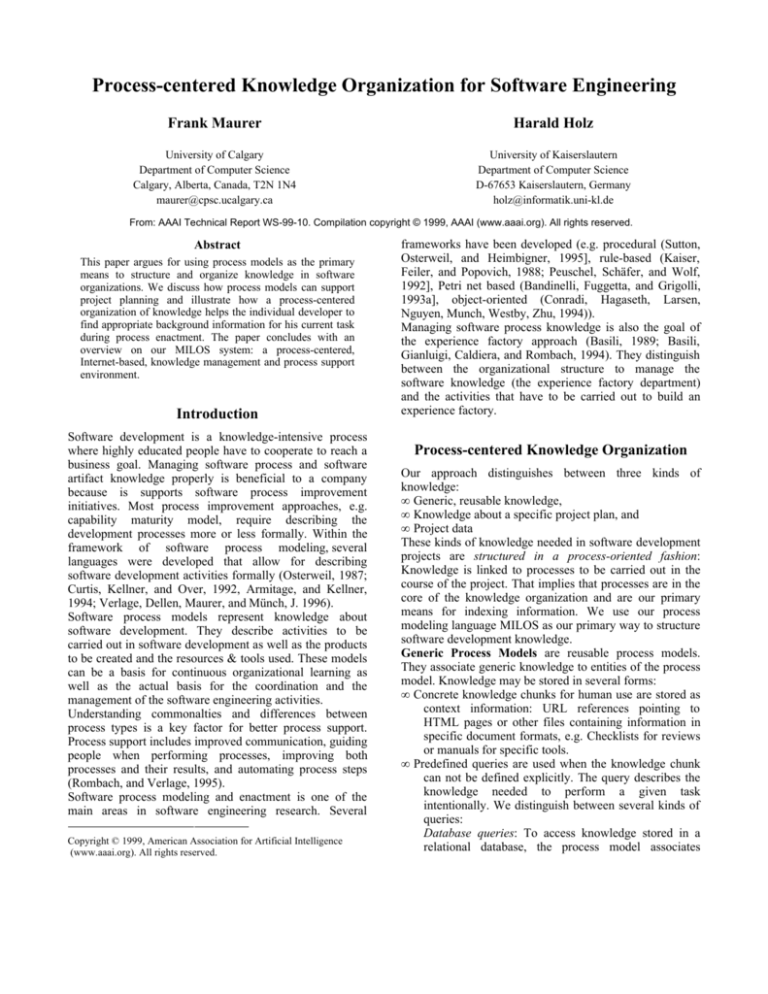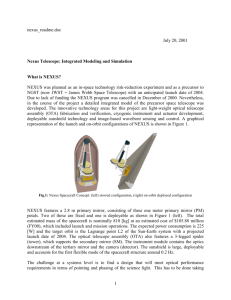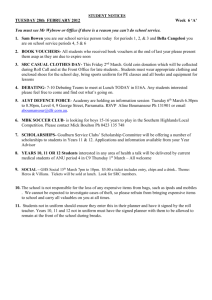
Process-centered Knowledge Organization for Software Engineering
Frank Maurer
Harald Holz
University of Calgary
Department of Computer Science
Calgary, Alberta, Canada, T2N 1N4
maurer@cpsc.ucalgary.ca
University of Kaiserslautern
Department of Computer Science
D-67653 Kaiserslautern, Germany
holz@informatik.uni-kl.de
From: AAAI Technical Report WS-99-10. Compilation copyright © 1999, AAAI (www.aaai.org). All rights reserved.
Abstract
This paper argues for using process models as the primary
means to structure and organize knowledge in software
organizations. We discuss how process models can support
project planning and illustrate how a process-centered
organization of knowledge helps the individual developer to
find appropriate background information for his current task
during process enactment. The paper concludes with an
overview on our MILOS system: a process-centered,
Internet-based, knowledge management and process support
environment.
Introduction
Software development is a knowledge-intensive process
where highly educated people have to cooperate to reach a
business goal. Managing software process and software
artifact knowledge properly is beneficial to a company
because is supports software process improvement
initiatives. Most process improvement approaches, e.g.
capability maturity model, require describing the
development processes more or less formally. Within the
framework of software process modeling, several
languages were developed that allow for describing
software development activities formally (Osterweil, 1987;
Curtis, Kellner, and Over, 1992, Armitage, and Kellner,
1994; Verlage, Dellen, Maurer, and Münch, J. 1996).
Software process models represent knowledge about
software development. They describe activities to be
carried out in software development as well as the products
to be created and the resources & tools used. These models
can be a basis for continuous organizational learning as
well as the actual basis for the coordination and the
management of the software engineering activities.
Understanding commonalties and differences between
process types is a key factor for better process support.
Process support includes improved communication, guiding
people when performing processes, improving both
processes and their results, and automating process steps
(Rombach, and Verlage, 1995).
Software process modeling and enactment is one of the
main areas in software engineering research. Several
Copyright © 1999, American Association for Artificial Intelligence
(www.aaai.org). All rights reserved.
frameworks have been developed (e.g. procedural (Sutton,
Osterweil, and Heimbigner, 1995], rule-based (Kaiser,
Feiler, and Popovich, 1988; Peuschel, Schäfer, and Wolf,
1992], Petri net based (Bandinelli, Fuggetta, and Grigolli,
1993a], object-oriented (Conradi, Hagaseth, Larsen,
Nguyen, Munch, Westby, Zhu, 1994)).
Managing software process knowledge is also the goal of
the experience factory approach (Basili, 1989; Basili,
Gianluigi, Caldiera, and Rombach, 1994). They distinguish
between the organizational structure to manage the
software knowledge (the experience factory department)
and the activities that have to be carried out to build an
experience factory.
Process-centered Knowledge Organization
Our approach distinguishes between three kinds of
knowledge:
• Generic, reusable knowledge,
• Knowledge about a specific project plan, and
• Project data
These kinds of knowledge needed in software development
projects are structured in a process-oriented fashion:
Knowledge is linked to processes to be carried out in the
course of the project. That implies that processes are in the
core of the knowledge organization and are our primary
means for indexing information. We use our process
modeling language MILOS as our primary way to structure
software development knowledge.
Generic Process Models are reusable process models.
They associate generic knowledge to entities of the process
model. Knowledge may be stored in several forms:
• Concrete knowledge chunks for human use are stored as
context information: URL references pointing to
HTML pages or other files containing information in
specific document formats, e.g. Checklists for reviews
or manuals for specific tools.
• Predefined queries are used when the knowledge chunk
can not be defined explicitly. The query describes the
knowledge needed to perform a given task
intentionally. We distinguish between several kinds of
queries:
Database queries: To access knowledge stored in a
relational database, the process model associates
1
predefined SQL queries with tasks . When a user
carries out the task, he will be able to click on the
query. Then the system will connect to the database,
query it and present the results to the user. An example
for such knowledge is a query that determines the
average time spent on coding of one class. Such a
query could be linked to a task “Estimate
implementation effort” and would help an
inexperienced project manager to determine the overall
time needed for implementing a system.
Information retrieval requests: Most of the information
produced or needed in software development is
unstructured and informal or semi-formal at best.
Requirements are typically documented as natural
language text. System designs are represented with
graphical notations (e.g. UML or ER diagrams) that
often use textual annotations to make things clear.
These representations can – partially – be accessed
using standard information retrieval mechanisms. An
IR request can be posted to one of the public web
search engines or to an in-house document
management system. An example is to find the newest
version of the Java EJB package for a task “Implement
Application Server” (the query would have to be
posted to the Javasoft retrieval engine).
CBR requests: Case-based reasoning technology
integrates structured and unstructured queries. It
supports similarity-based queries on structured data
whereas relational databases mainly use Boolean
queries and IR systems work with unstructured data. If
a company would annotate software life cycle
documents with attributes and store them in a case
base, then one could imagine to apply CBR technology
for software process support.
Project Plans adapt generic process models to the needs of
a concrete project. This tailoring includes
• selecting processes and methods from the generic
process model that should become part of the project
plan. For example, the generic process model contains
a process "testing" with methods "White box testing"
and "Code reading". The project manager adds a
"Testing" process to the project plan and then selects
"code reading" as the method of choice.
• standard project planing: Assigning tasks to responsible
agents, scheduling tasks, cost estimation etc.
Tailoring process models is a difficult task and many
problems are still unresolved, e.g.:
• how to determine that a generic model can be reused in a
given situation
• how to support the customization process.
Project plans contain the knowledge about tasks to be done
and links to the knowledge contained in generic process
models. They are a basis for project enactment and
coordination. Using a process enactment engine in a
project, a project plan is the basis for actively guiding
human users in their work.
1
In the following, task and process are used synonymously.
Project Data is handled by a flexible workflow/process
engine. This manages the state of the work process and its
tasks, to-do lists for its users, the products created during
process enactment, traceability relationships between
process entities (Dellen, Kohler, Maurer 1996), etc. This
information is created during process execution and,
obviously, is highly relevant for the current project. In
software development processes this includes e.g.
requirements specifications, design documents, design
rationales, traceability matrixes, source code etc.
Our approach provides - beside a product-oriented view
coming from the software configuration management
system used - also a process-oriented view on the data
created during task enactment. Users are able to access
information based on the processes carried out and they can
follow the information flow in the project (thereby tracing
where and by whom a specific information was used).
Integrating Process Modeling,
Project Planning & Enactment
To support an organizational learning process, our
approach links process-centered knowledge management,
with project planning, enactment support and experience
packaging. Using our system is basically a four step
process (see Fig 1).
Process
Model
1
Project
Plan
Workflow
2
4
Experience
Packaging
3
Figure 1: Knowledge Utilization Cycle
Process models describe generic tasks, their decomposition
into subtasks, and the information flow between tasks (for a
more detailed description see (Maurer, Dellen 1998)).
The library of process models contains descriptions of best
practices in software development for a given company. In
step 1, the project manager selects processes and methods
from the library creating an initial project plan. This plan
includes references to background knowledge (context
URLs and queries) that were stored in the process model.
The plan is uploaded to standard project management tools
(currently we support MS-Project 98 and use it for
scheduling and assigning tasks to resources) or changed
using our project planning editors. Changes carried out with
MS-Project are then downloaded to our system. In the
upload/download process, we preserve information flow
dependencies between tasks as well as links to background
knowledge coming from the process model.
The planning process is incremental: We can change the
plan at any time during process execution. The current
project plan is the basis for our workflow engine (MILOS
WFE) (2). Using a standard Web browser, a user is able to
connect to the WFE, access her to-do list,
accept/reject/restart a task, access task inputs, and edit task
outputs. After finishing a task, the outputs are accessible as
input in the successor tasks. We are currently working on
the query functionality and the feedback cycle. A user will
then be able to select parts of the project plan (3) and
generate an equivalent partial model in the experience
factory that stores all process models (4).
input documents that are not part of the information flow
defined by the method, and hence have to be produced by
some other processes in the plan.
The MILOS System
In the following, we illustrate our system’s functionality
with the help of an example scenario describing our own
project’s software development process.
Figure 3: Planning decision.
Next, the planner decides on the design method to be used
for the process “Design WFE”. The corresponding process
type already contains specifications for the methods
“UML”, “OMT” and “SDL”. After having settled on
“UML”, he queries the project’s resource pool for qualified
personnel that match the profile specified for this method in
the process model. Since more than one team member has
both design experience and is familiar with UML, the
project planner tries to refine his query. He searches in the
company’s project plan database for former instances of
type
“Design”.
In
particular,
he
looks
for
Figure 2: Example process model.
Using the requirements document and the architecture
description as a basis, the project planner browses the
process model shown in Fig. 2. He retrieves the process
type “Develop Component”. For each of the three
architectural components Project Plan Management
(PPM), Workflow Engine (WFE) and Resource Pool (RP)
component to be developed during the project, he inserts an
appropriately named instance of this type into the plan (e.g.
“Develop WFE Component”).
The process type “Develop Component” maintains
knowledge about different development methods, e.g.
“waterfall” or “iterative enhancement”. Hence, the planner
can proceed by selecting one of these methods for the
process “Develop WFE Component”(see Fig. 3). By
choosing the method “waterfall”, instances of the method’s
subprocess types “Design”, “Implement”, “Test” and “QAnalyze” are automatically inserted into the plan. In
addition to the knowledge chunks and queries these
instances obtain from the model, they specify their required
input documents and output documents to be produced
during process execution. The planner is alerted to any
Figure 4: View on partial plan with MS-Project.
former design processes whose task description contains
keywords like “workflow” or “event”, since the task at
hand is the design of a flexible workflow engine based on
event handling. Since only for Bob several design processes
are found that dealt with event handling, the planner
assigns the process “Design WFE” to him.
Likewise, the planner proceeds with the remaining
processes. The screenshot taken from MS-Project in Fig. 4
shows a partial plan for developing the MILOS system.
Also shown is some scheduling information, i.e. planned
start and finish times, duration as well as team members
assigned to each task. In addition to the information shown
in Fig. 4, the plan also contains a loop from Test WFE back
to Implement WFE. This loop is modeled by specifying a
product flow between those two processes, using MSProject’s additional task attribute fields.
For plan enactment, the project planner exports the plan
from MS-Project into MILOS. From now on, team
members, regardless of their geographical location, can log
into MILOS via standard Web browsers and are provided
with individual workspaces. Figure 5 shows the current
workspace of team member Alice. According to the project
plan, she is responsible for the task Implement WFE and,
consequently, this task appears on her to-do list.
Fig. 5: MILOS workspace for Alice.
The workspace allows Alice to browse the information
associated with each task, e.g. a more detailed task
description (including the task hierarchy) and scheduling
information. In particular, she is given access to any
documents needed to execute the task. Hence, the list of
input documents (the design document and the
requirements document) as well as the list of output
documents is displayed for task Implement WFE. These
lists can be specified in the project plan. A double-click on
a document opens it with the appropriate tool.
As soon as the required input document WFE design has
been released by Bob, the team member who is responsible
for task Design WFE (see Fig. 4), Alice is notified that the
task Implement WFE has become executable. In addition to
the input documents specified in the plan, Bob added the
document Publish/Subscribe-Pattern as a context URL to
Alice’s task. Thus, during the implementation Alice will be
given easy access to important information that helps her to
better understand both the design and related
implementation issues.
Before she starts working on the task, Alice lets the system
estimate its duration. This estimate is based on the number
of classes/methods in the design document and Alice’s
average coding speed (retrieved by a query associated with
the task). According to this estimate, she forecasts her start
and finish times for the implementation to be the current
date (Dec. 14) and Dec. 17, respectively. In the case that
her forecast violated the project schedule, the planner
would receive an automatically generated email
notification about this problem. However, since her
forecast conforms to the schedule, no notification is sent.
A double-click on the (empty) output document WFE
implementation starts the appropriate Java implementation
environment for Alice. At the end of each day that she is
working on this task, she can save her work and specify a
"percentage complete" value for it. This value will be
exported from MILOS back to MS-Project in order to
provide the planner with up-to-date information on the
project.
When she is finished with the task, it will be removed from
her to-do list. In addition, the document WFE
implementation is released, to the effect that the two
succeeding tasks Test WFE and Q-Analyze WFE become
executable. According to the plan (see Fig. 4), the former
has not been assigned to any team member yet, while the
latter has been assigned to a specific metric tool. This tool
acts as a software agent that performs the task
automatically as soon as it becomes executable.
Depending on these measurements, the planner might want
to refine the task Test WFE to either a black-box or whitebox testing process. In our example, the planner settles for
white-box testing because of a high number of conditional
expressions in Alice's code. Hence, he refines the task Test
WFE by creating two new subtasks Write WFE Test Cases
and Run WFE Test Cases. In addition, he schedules these
two new tasks and updates his former estimate on the finish
time of the task Test WFE. Because this former estimate
was based on his optimistic assumption that black-box
testing would suffice, the planner now allocates more time
for task Test WFE. As a consequence, the schedule for the
succeeding tasks System Integration and System Test also
has to be changed.
When he is finished with updating the project plan, the
planner exports it again into MILOS. This causes the two
newly created tasks to appear on the to-do lists of those
team members the tasks were assigned to. In addition, the
team members responsible for the tasks whose time
scheduling had to be changed receive a corresponding
notification. This allows them to update their own work
schedule, in particular their forecasts on start and finish
times.
In case any problems with Alice's code should be
encountered during task Run WFE Test Cases, an MSWord document containing a description of the problems
will be created as output. The presence of this document
will cause a restart of the task Implement WFE, i.e. it will
appear once again on Alice's to-do list, together with the
problem report as an additional input to the task. However,
since by now the calendar has advanced to Dec. 28,
whereas the implementation task was scheduled to finish by
Dec. 18, the planner will receive an automatically
generated email about this delay. That way, he will have
the opportunity to correct the plan in time if project
deadlines make this update necessary.
Meanwhile, Alice will release a new version of the
document WFE implementation as soon as she has
corrected the code. Analogous to the restart of task
Implement WFE, the release of a new WFE implementation
document version will cause a restart of the succeeding
tasks Test WFE and Q-Analyze WFE. That way, a single
restart might cause a "restart-cascade" that reaches all tasks
affected by a change in a document.
Discussion
In this paper we described the MILOS system, an Internetbased
process-centered
knowledge
management
environment. The environment structures knowledge
around work processes: In the center of our representation
are processes. Linked to a process, the user can find
methods (describing ways how to perform the process to
reach its goals), products (input and outputs to the process),
factual knowledge in the form of product instances (often
implemented as web references), and knowledge about the
qualifications needed to perform the process.
The process-centered structure of the system has the
following advantages:
• Processes are “natural“ entities for managers and team
members: they are well used to thinking in processes
(e.g. for project planning).
• For their daily work, people don’t need knowledge perse but knowledge for performing specific tasks. A
process-centered knowledge management system
associates explicitly the task with the knowledge
needed for it.
By linking web references to task, the lost in hyperspace
problem is reduced because the user immediately finds the
knowledge needed instead of being forced to browse to
relevant pages.
A process engine that guides the human users in their daily
work interprets the explicit description of processes. This
guidance is especially useful for new employees because
they lack the knowledge about the standard procedures of a
company.
The feedback cycle creates a learning software
organization: we provide a tool that allows to package
“good” elements of successful project plans into reusable
process models. This technology supports the
implementation of a continuous process improvement
strategy for software companies.
Acknowledgements
The work on the MILOS system was supported by NSERC,
The University Of Calgary, Nortel and DFG with several
research grants.
We would like to thank Barbara Dellen, Fawsy Bendeck,
Sigrid Goldmann, and Boris Koetting for their valuable
input. The user interfaces of MILOS were implemented by
Mike Gao.
References
Armitage, J., and Kellner, M. (1994). A conceptual schema
for process definitions and models. In D. E. Perry, editor,
Proceedings of the Third International Conference on the
Software Process, IEEE Computer Society Press.
Bandinelli, S., Fuggetta, A., and Grigolli, S. (1993).
Process Modeling-in-the-large with SLANG. In IEEE
Proceedings of the 2nd International Conference on the
Software Process, Berlin (Germany).
Basili, V. R. (1989). The Experience Factory: packaging
software experience. In Proceedings of the Fourteenth
Annual Software Engineering Workshop, NASA Goddard
Space Flight Center, Greenbelt MD 20771.
Basili, V. R., Caldiera, G., and Rombach, H. D. (1994).
Experience Factory. In Encyclopedia of Software
Engineering (J. J. Marciniak, ed.), vol. 1, John Wiley Sons.
Conradi, R., Hagaseth, M., Larsen, J. O., Nguyen, M.,
Munch, G., Westby, P., and Zhu, W. (1994). EPOS:
Object-Oriented and Cooperative Process Modeling. In
PROMOTER book: Anthony Finkelstein, Jeff Kramer and
Bashar A. Nuseibeh (Eds.): Software Process Modeling and
Technology, 1994. Advanced Software Development
Series, Research Studies Press Ltd. (John Wiley).
Curtis, B., Kellner, M., and Over, J. (1992). Process
modeling. Communications of the ACM, 35(9): 75–90.
Dellen, B., Kohler, K., and Maurer, F. (1996). Integrating
Software Process Models and Design Rationales. In
Proceedings of Knowledge-Based Software Engineering
Conference (KBSE-96), IEEE press.
Kaiser, G. E., Feiler, P. H., and Popovich, S. S. (1988).
Intelligent Assistance for Software Development and
Maintenance, IEEE Software.
Maurer, F., Dellen, B. (1998). A concept for an Internetbased
process-oriented
knowledge
management
th
environment, in: Gaines, B.R., Musen, M.: Proc. 11 Banff
Knowledge Acquisition Workshop, Banff, Alberta, Canada.
Osterweil, L. (1987). Software Processes are Software Too.
In Proceedings of the Ninth International Conference of
Software Engineering, Monterey CA, pp. 2-13.
Peuschel, P., Schäfer, W., and Wolf, S. (1992). A
Knowledge-based Software Development Environment
Supporting Cooperative Work. In: International Journal on
Software Engineering and Knowledge Engineering, 2(1).
Rombach, H.-D., and Verlage, M. (1995). Directions in
software process research. In M. V. Zelkowitz (Eds.),
Advances in Computers, vol.41. Academic Press.
Verlage, M., Dellen, B., Maurer, F., and Münch, J. (1996).
A synthesis of two software process support approaches. In
th
Proceedings 8 Software & Engineering and Knowledge
Engineering (SEKE-96), USA.






